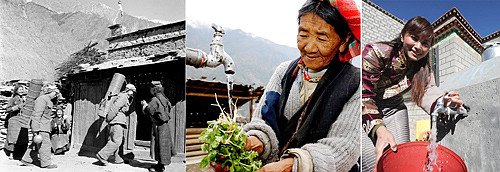|
 |
|
GREAT CHANGES: While PLA soldiers had to carry water for a Tibetan family in Lhunze County in 1962, tap water is now available in most Tibetan households (XINHUA) |
How do you recognize traditional Tibetan culture?
Traditional Tibetan culture is an important part of traditional Chinese culture. For thousands of years, Tibetan culture has coexisted with inland culture. The two cultures have borrowed extensively from each other.
For example, the golden roof and bracket building style (a system of brackets inserted between the top of a column and a crossbeam) of the Potala Palace and several other famous monasteries in Lhasa are clearly borrowed from architectural styles used in inland areas of China. The painting, dance, sculpture, medicine, calendar and religion of Tibet have also been influenced greatly by inland culture.
Tibetan culture has also continuously instilled vigor to mainstream Chinese culture.
Having incorporated South Asian, and indigenous highland elements, Tibet's own culture is very distinctive, and Tibetan and Chinese culture have been drawn to each other for centuries.
How is it possible to develop Tibetan culture in a modern context?
It is a universal law that culture evolves with social and economic development. What is called "traditional Tibetan culture" is sure to progress with the times and the improvement of people's livelihoods.
Traditional Tibetan culture has many centuries of history and inevitably shows the imprints of the region's feudal past. These feudal elements must be abandoned as Tibet's society develops but the positive elements of Tibetan culture should be retained and carried forward.
New cultural programs and art forms have been created to reflect Tibet's modernization and to meet public demand.
Some Westerners claim ancient Tibetan culture is incomparably sacred and oppose any change to it, but this logic will render Tibet a cultural fossil, a place for privileged Westerners to gawk at.
Meanwhile, the Dalai clique has spread the rumor about a "Tibetan cultural genocide," with the aim to recover the cultural privileges they used to enjoy under the feudal system.
China's rapid development has provided Tibetan culture with conditions in which it can flourish. In such fields as publishing, radio and TV broadcasts, photography, fine arts, music and costumes, new cultural forms are evolving by integrating modern technology and ideas with traditional elements. All this vibrancy was impossible in the stagnant old Tibet. | 